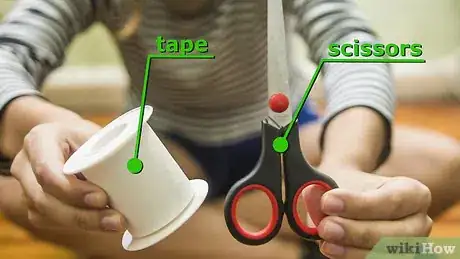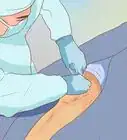This article was co-authored by Michele Dolan. Michele Dolan is a BCRPA certified Personal Trainer in British Columbia. She has been a personal trainer and fitness instructor since 2002.
This article has been viewed 457,064 times.
Coping with an injured or painful knee is hard, but taping it can provide some relief. Not only that, but taping your knee also adds support for your knee. To tape your knee, you'll need to first place crossing strips on either side of your leg, framing your knee. Then, anchor your straps by wrapping more tape around your knee. If you have a tape allergy, you should apply a hypo-allergenic base, first.
Steps
Placing Crossing Strips
-
1Sit down on a flat surface. Great options include the floor or an elevated table, depending on what's available to you. Although a table may make it easier for someone else to wrap your knee, you need to make sure it's stable.[1]
-
2Elevate your knee with a rolled towel or similar item (optional). This should put your knee at a 30 degree angle. Although you don't have to do this, it makes it easier to hold your knee in place during the wrapping.
- Without the support of a towel or similar object, you may find it too tiring or painful to hold your knee in place.
- If you don't want to use a towel, you could try a water bottle or a round foam massaging roller.
Advertisement -
3Apply a hypo-allergenic base, if you're allergic to sports tape. The base layer, which goes under your tape, will protect you from an allergic reaction. Make sure that your entire knee is covered in a base layer before you start wrapping your knee.
- It's best to wrap your knee with the base layer using the same method as you're using for your actual sports tape. Simply follow the procedure for wrapping your knee, but use the base layer instead of your sports tape.
- Once your base layer is in place, apply your sports tape.
-
4Cut 14–15 inch (35.6–38.1 cm) strips of sports tape. Use scissors to cut your tape. If you're using pre-cut tape, simply pull the strips off the roll, as they're needed. This will be the standard strip length for this procedure.
- Most pre-cut rolls have 14 inch (35.6 cm) strips.
-
5Apply the strip to your knee. Place one end of the strip about 4 inches (10.2 cm) above the knee, in the center of the thigh. Then, slowly smooth it down along the outside of your leg, crossing over the side of your knee.[2]
- The strip should finish in the center of the calf, below the back of the knee.
- All strips should be placed so that circulation will not be cut off.
- It is best to always have a little tension when placing each strip. Do not pull hard or let the strip hang loose.
-
6Add the next strip, starting below the knee and moving up. Place one end of a second strip of cut tape about 4 inches (10.2 cm) below the knee, in the center of the shin. Slowly smooth the strip up the outside of your leg, crossing over the side of the knee and intersecting the first strip on the side of the knee. The strip should finish in the center of the thigh, above the back of the knee.[3]
-
7Apply the strips to the inside of your knee. Repeat steps 2 through 5 on the inside of the knee to mirror the first two strips.[4]
- This should create an X on each side of the knee.
- The ends of both X’s should start and stop in the same place.
Placing Anchors
-
1Cut out a strip of tape that will go around your whole thigh. This length will vary person to person. You may want to measure your thigh before you cut the tape so that you don't waste any.
-
2Apply the first anchor strap. Place one end of the strip on top of the ends of the two strips already placed, which should be 4 inches (10.2 cm) above the knee. This will be the top of your "X."[5]
-
3Wrap the piece around the leg. Go slowly so that your application is even. Cover the ends of the two strips on the back of your thigh. Finally, finish where you started.
- This anchors the crossing strips down.
-
4Cut out a strip of tape that will go around your whole calf. This length will vary person to person. You may want to measure the tape before you cut it so that you don't risk wasting a piece.
-
5Start this anchor at the lower points of your "X." Place one end of the strip on top of the ends of the two strips already placed, which should be 4 inches (10.2 cm) below your knee. Slowly wrap the piece around the leg, covering the ends of the two strips on the back of the calf. You should finish in the same place where you started, creating a circle around your leg.[6]
- This serves as another anchor.
Expert Q&A
Did you know you can get expert answers for this article?
Unlock expert answers by supporting wikiHow
-
QuestionI hyper-extended my right knee 2 days ago. I am in gymnastics, and I really cannot afford to take it easy right now. It hurts right below my knee cap on the top of my shin bone. Any suggestions? :)
 Michele DolanMichele Dolan is a BCRPA certified Personal Trainer in British Columbia. She has been a personal trainer and fitness instructor since 2002.
Michele DolanMichele Dolan is a BCRPA certified Personal Trainer in British Columbia. She has been a personal trainer and fitness instructor since 2002.
Certified Fitness Trainer
-
QuestionWhat do I do if a person has varicose veins?
 Michele DolanMichele Dolan is a BCRPA certified Personal Trainer in British Columbia. She has been a personal trainer and fitness instructor since 2002.
Michele DolanMichele Dolan is a BCRPA certified Personal Trainer in British Columbia. She has been a personal trainer and fitness instructor since 2002.
Certified Fitness Trainer
-
QuestionWhat is the best for patella support when taping my knees?
 Community AnswerWrap your whole knee in prewrap, then roll until it is one strip below the patella.
Community AnswerWrap your whole knee in prewrap, then roll until it is one strip below the patella.
Warnings
- If you experience an increase in pain, or numbness, stop what you are doing. If the symptoms persist, seek medical help.⧼thumbs_response⧽
- Please do not attempt this if you have a fracture or other serious injury, or have circulatory problems.⧼thumbs_response⧽
- If you have a skin allergy, consult your doctor before choosing this method of treatment.⧼thumbs_response⧽
- Taping depends on the nature of your injury, and/or your anatomy. Consult a medical professional for advice before you begin.⧼thumbs_response⧽
- Taping your knee does not guarantee absolute protection or support for your knee⧼thumbs_response⧽
Things You'll Need
- Sports/athletic tape - roll or pre-cut (adhesive, non-stretch, hypo-allergenic)
- Rolled up towel, large water bottle, or similar object to place under your knee
- Scissors (if your tape is not pre-cut)
- Hypo-allergenic base tape or pre-wrap (optional)
References
- ↑ http://www.sportsinjuryclinic.net/sport-injuries/knee-pain/mcl-sprain/taping-medial-ligament-sprain
- ↑ http://www.sportsinjuryclinic.net/sport-injuries/knee-pain/mcl-sprain/taping-medial-ligament-sprain
- ↑ http://www.sportsinjuryclinic.net/sport-injuries/knee-pain/mcl-sprain/taping-medial-ligament-sprain
- ↑ http://www.sportsinjuryclinic.net/sport-injuries/knee-pain/mcl-sprain/taping-medial-ligament-sprain
- ↑ http://www.sportsinjuryclinic.net/sport-injuries/knee-pain/mcl-sprain/taping-medial-ligament-sprain
- ↑ http://www.sportsinjuryclinic.net/sport-injuries/knee-pain/mcl-sprain/taping-medial-ligament-sprain
About This Article
If you need to tape an injured knee, sit down on a flat surface. Place a strip of sports tape about 4 inches above your knee, in the center of your thigh. Slowly smooth the tape down along the outside of your leg, crossing over the side of your knee. Add another strip, this time starting below the knee and moving up. Apply 2 more strips on the inside of your knee, creating an X on each side of the knee. Finish by wrapping one strip of tape around your thigh at the top of the Xs and another around your calf at the bottom. Keep reading for tips from our reviewer on how to apply a hypoallergenic base if you’re allergic to sports tape!


























































Medical Disclaimer
The content of this article is not intended to be a substitute for professional medical advice, examination, diagnosis, or treatment. You should always contact your doctor or other qualified healthcare professional before starting, changing, or stopping any kind of health treatment.
Read More...